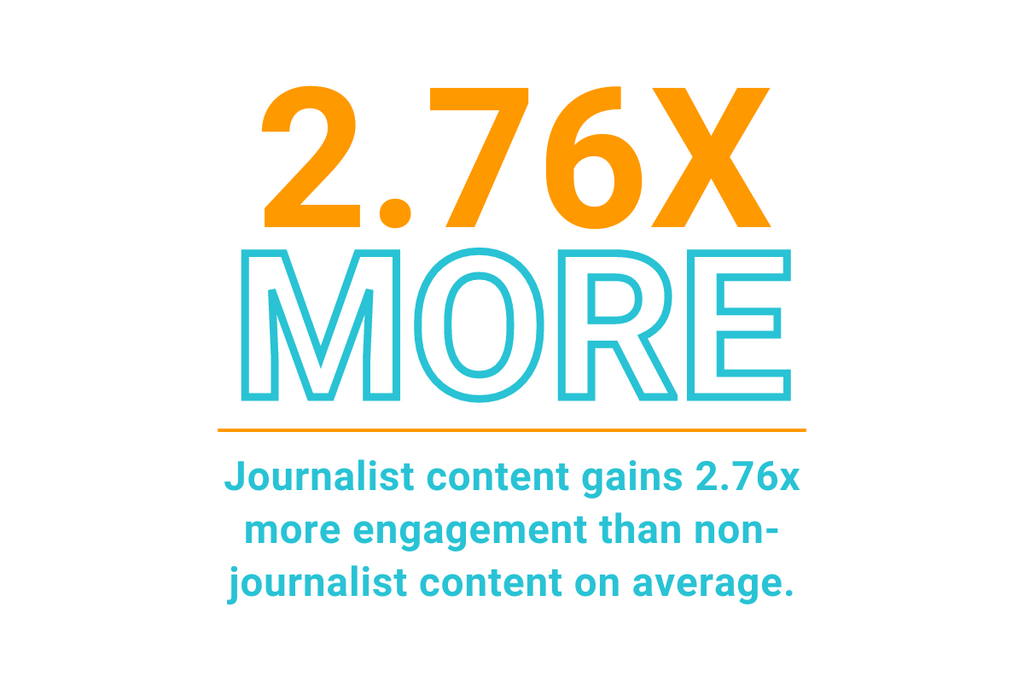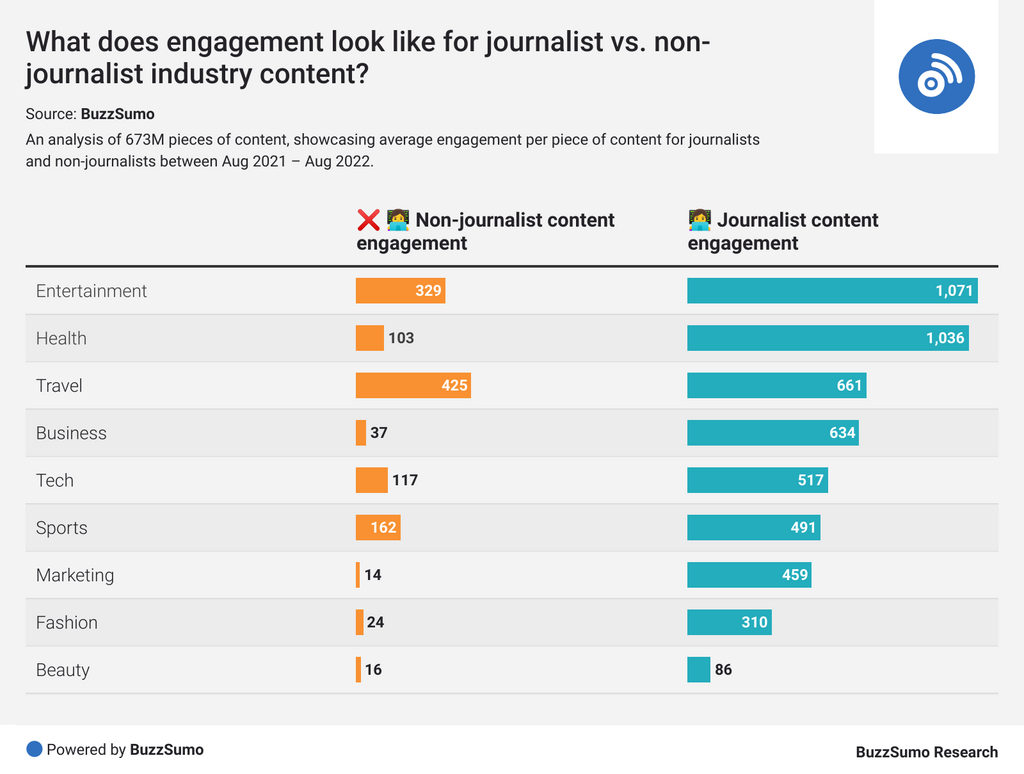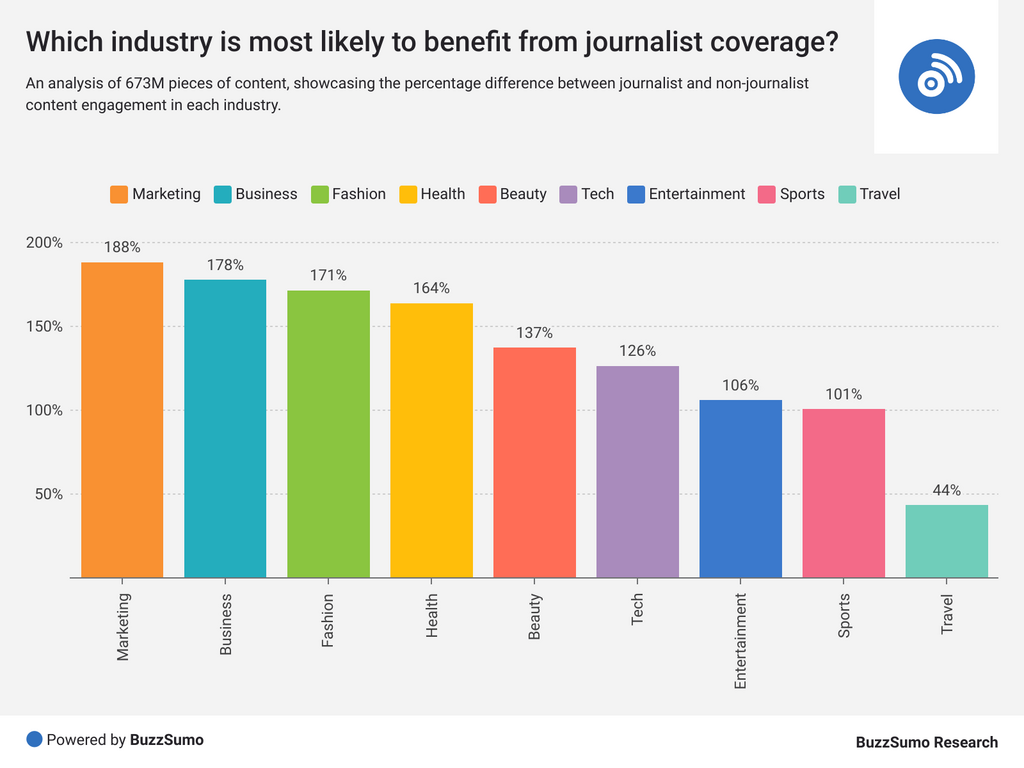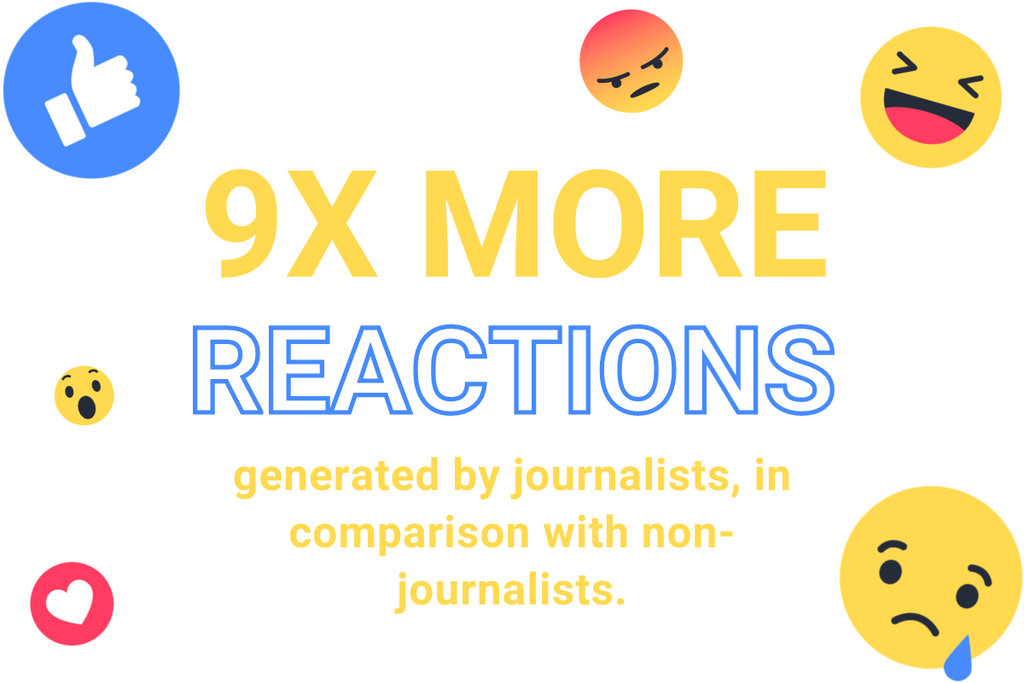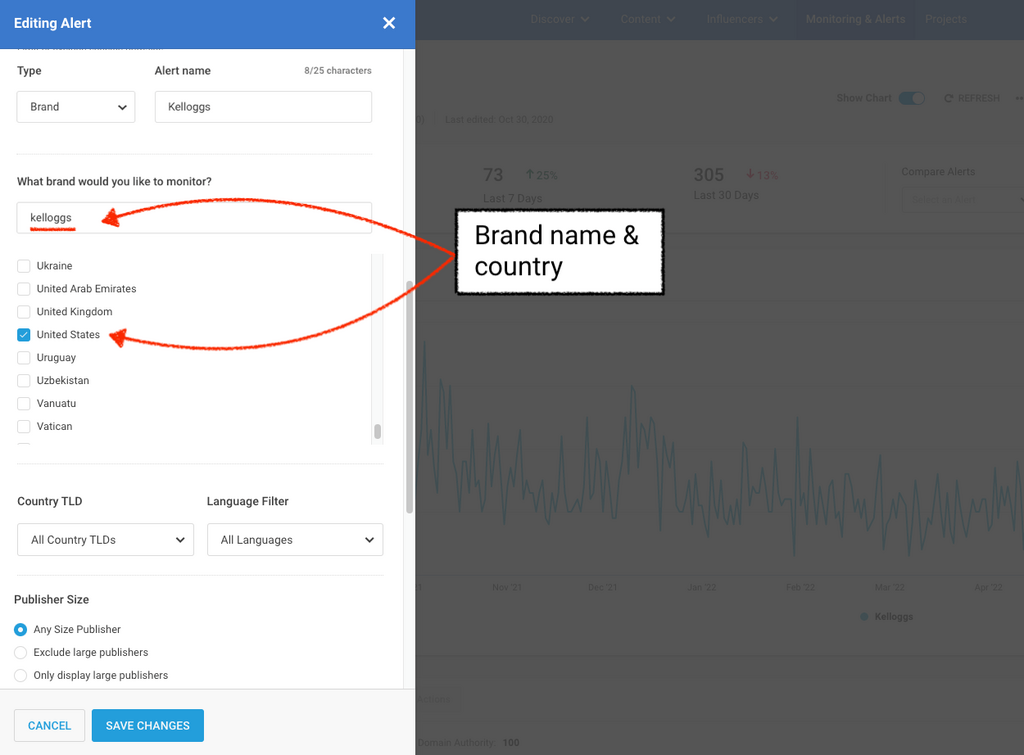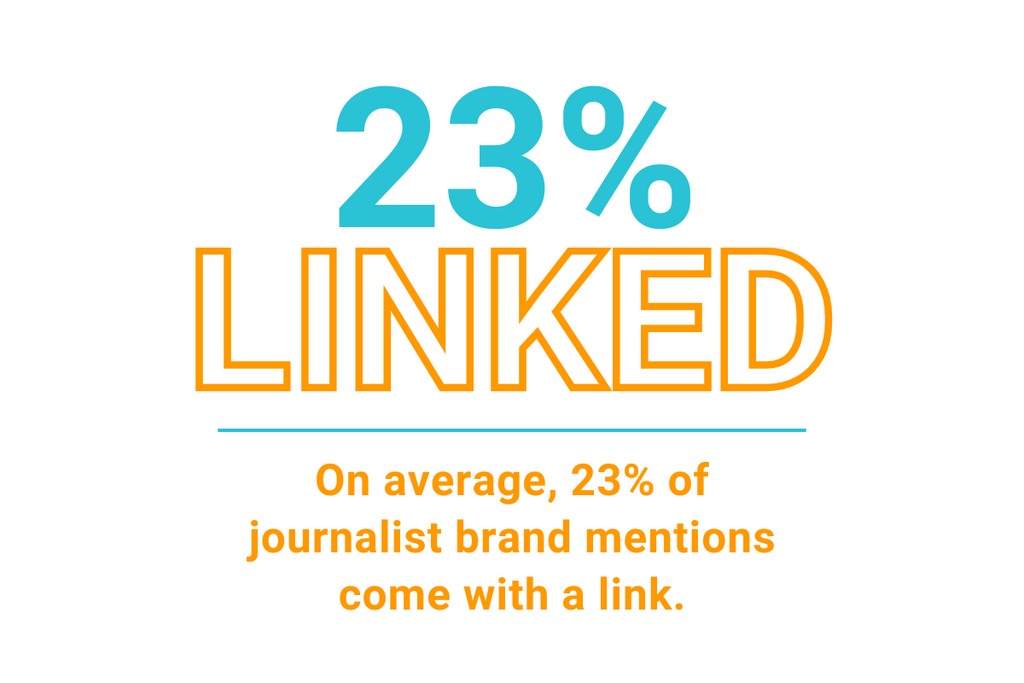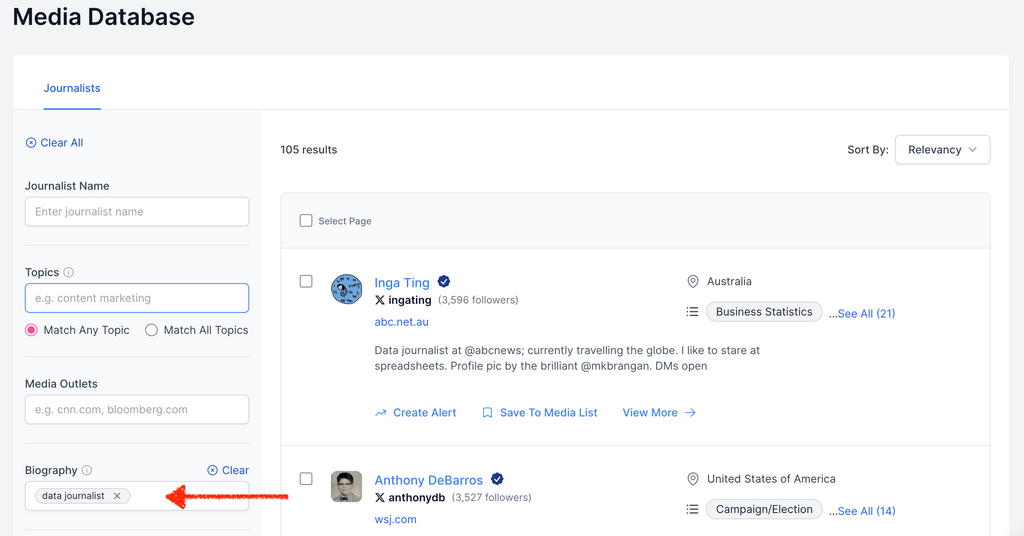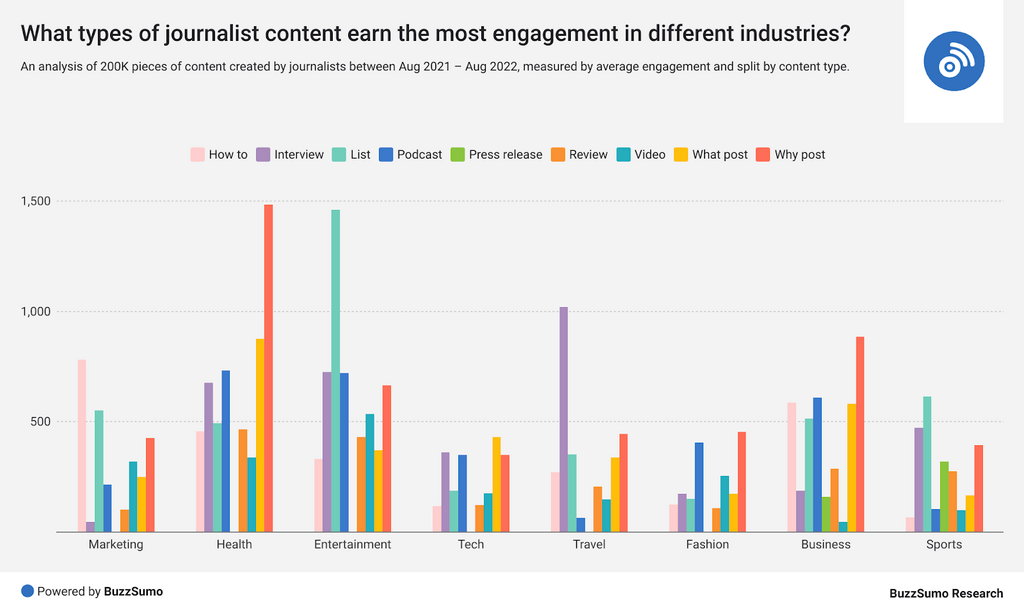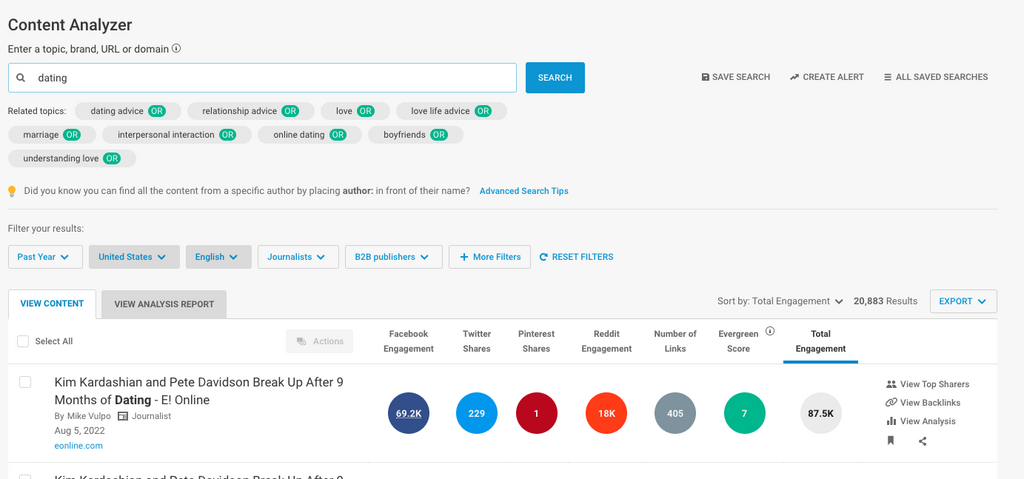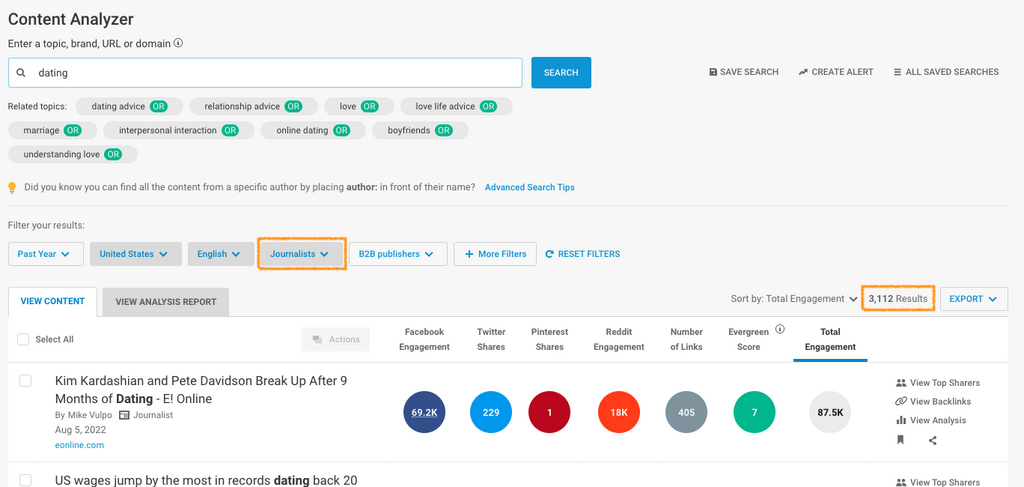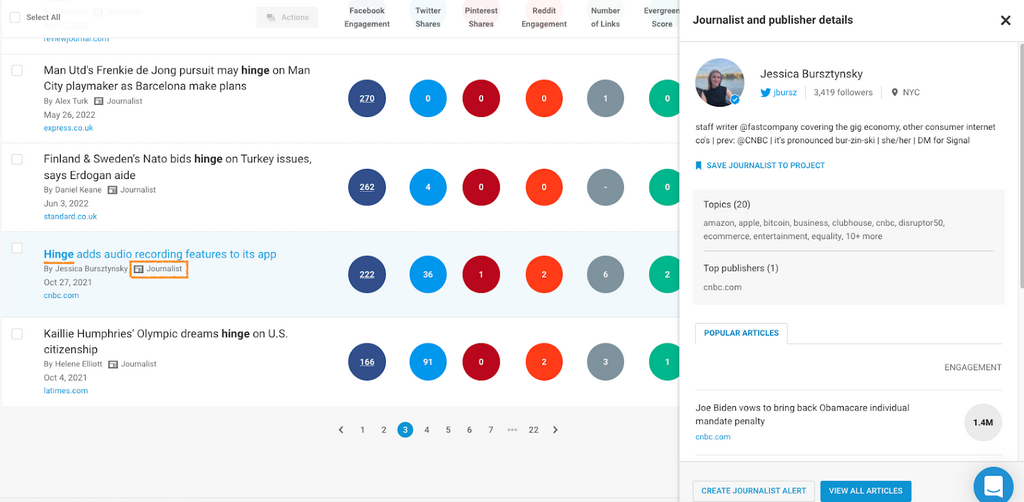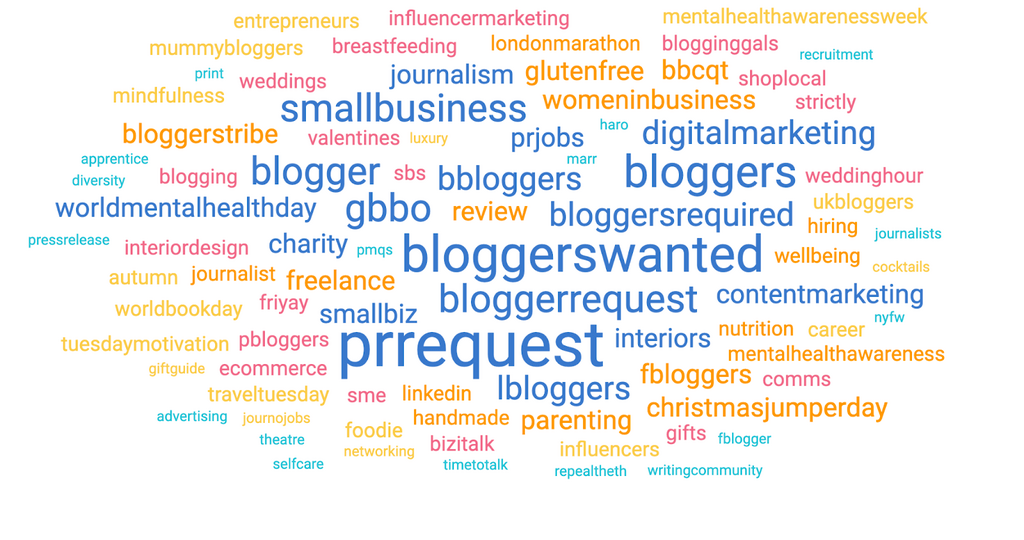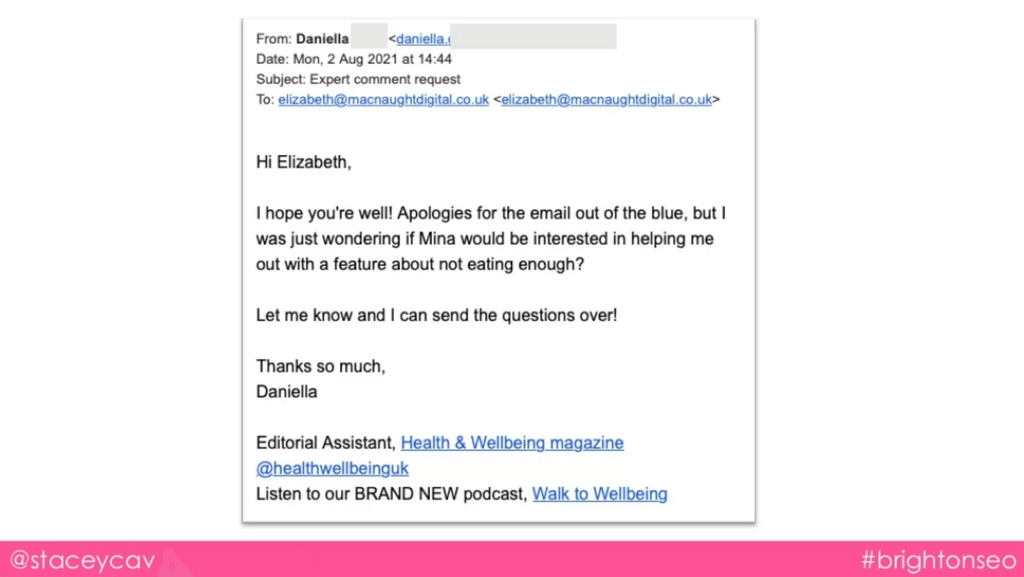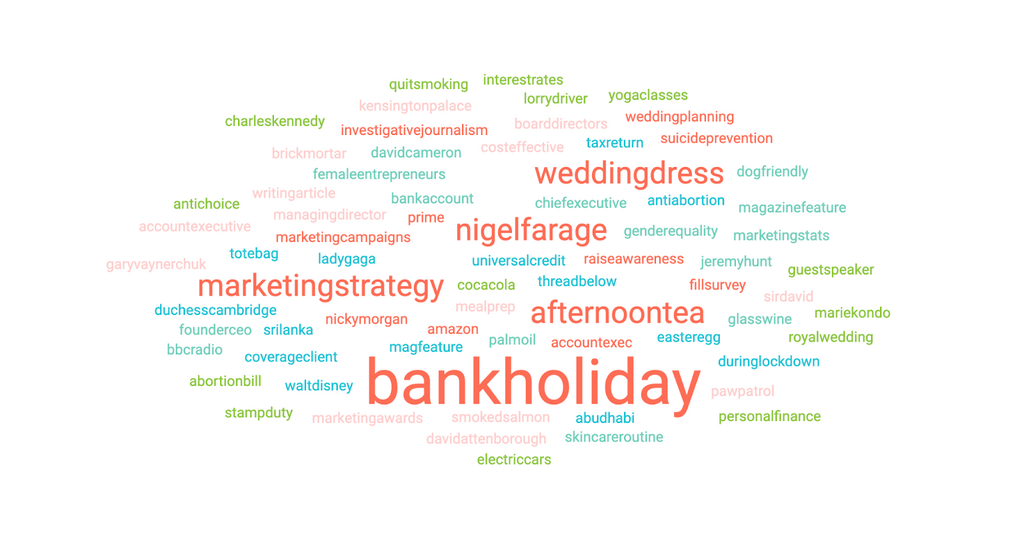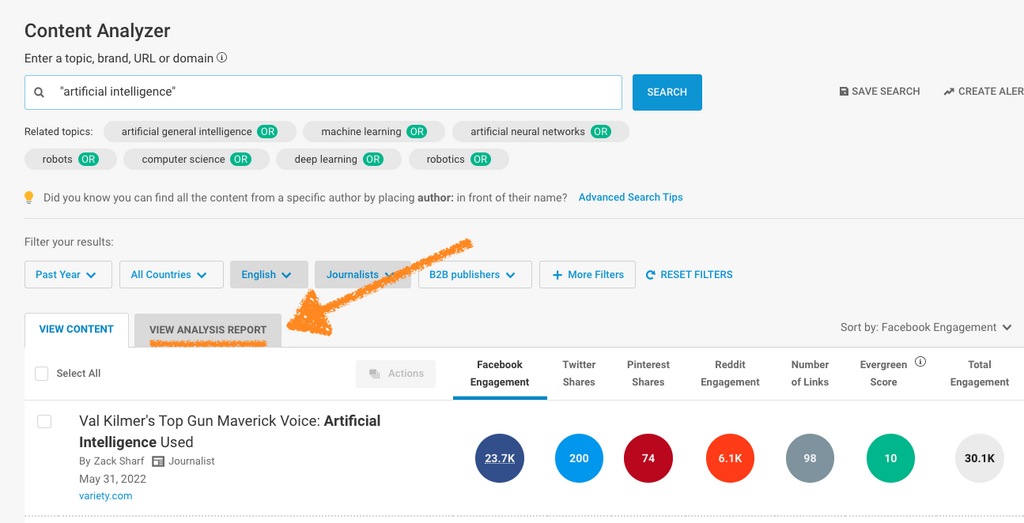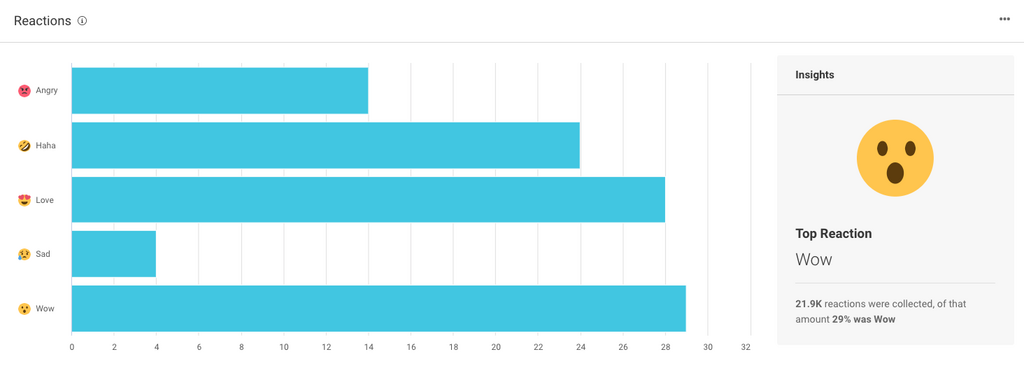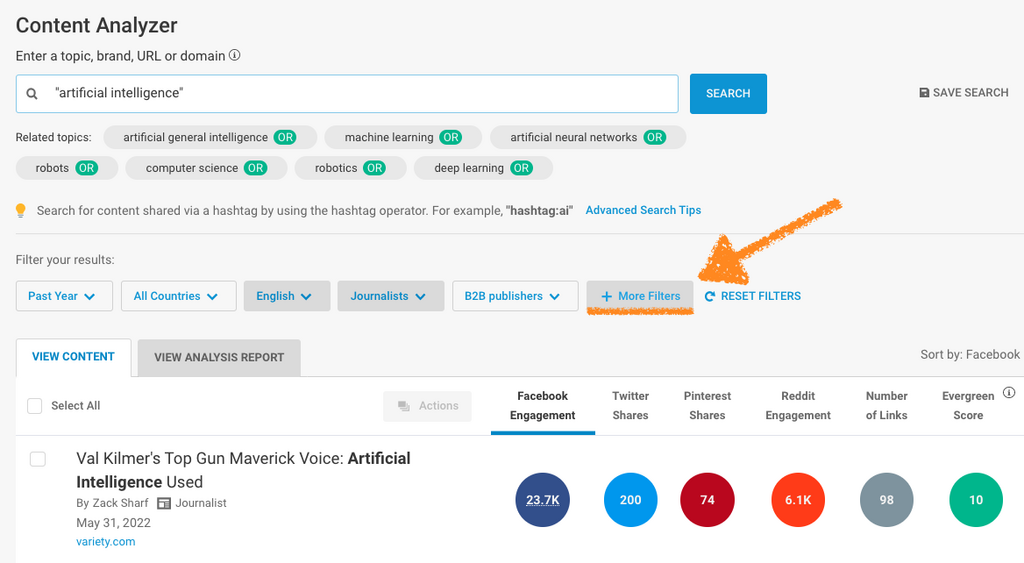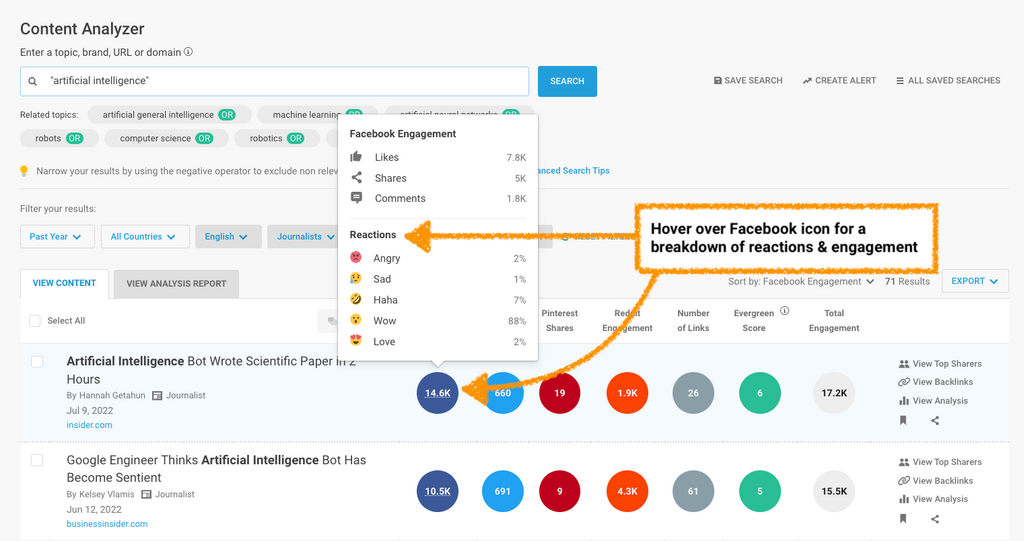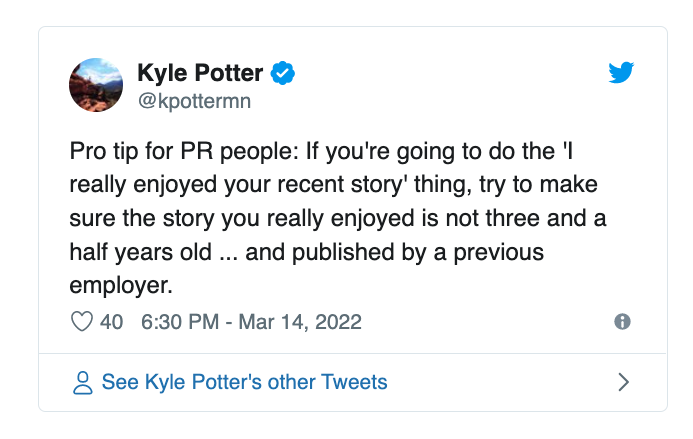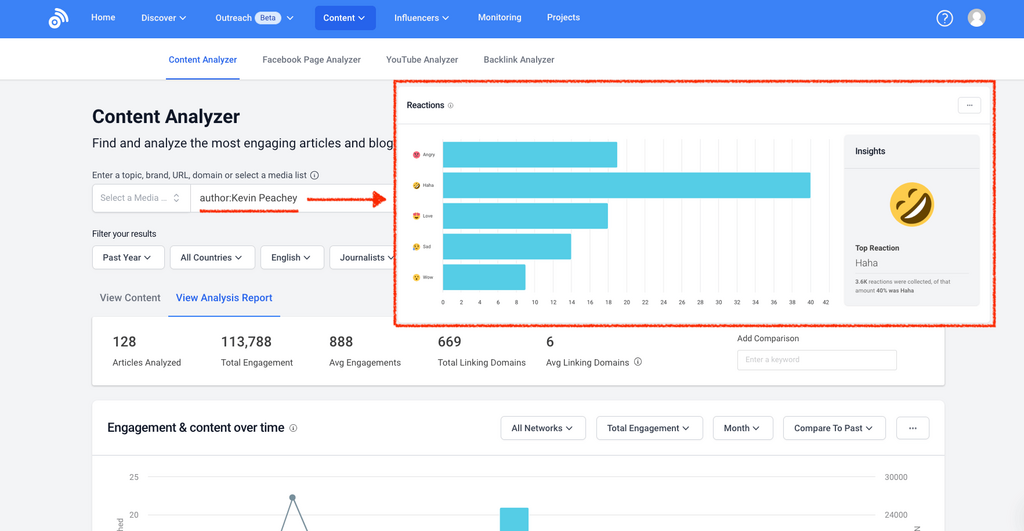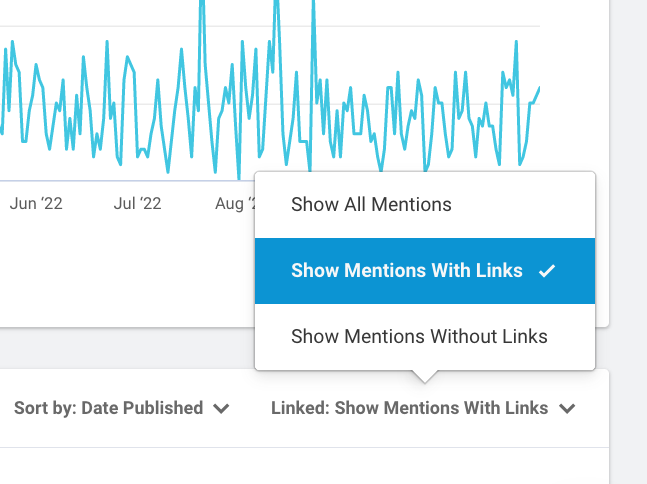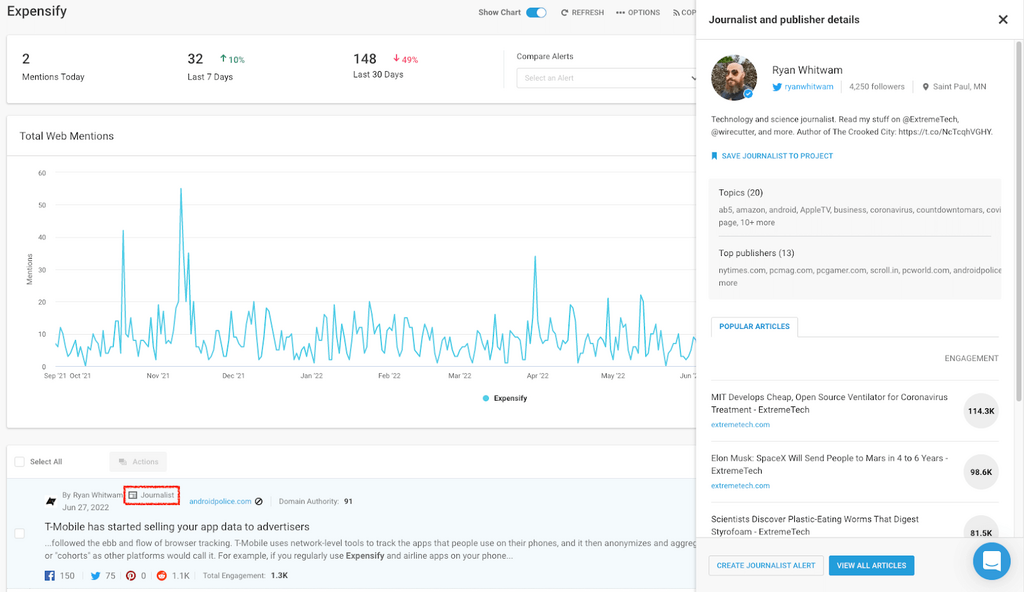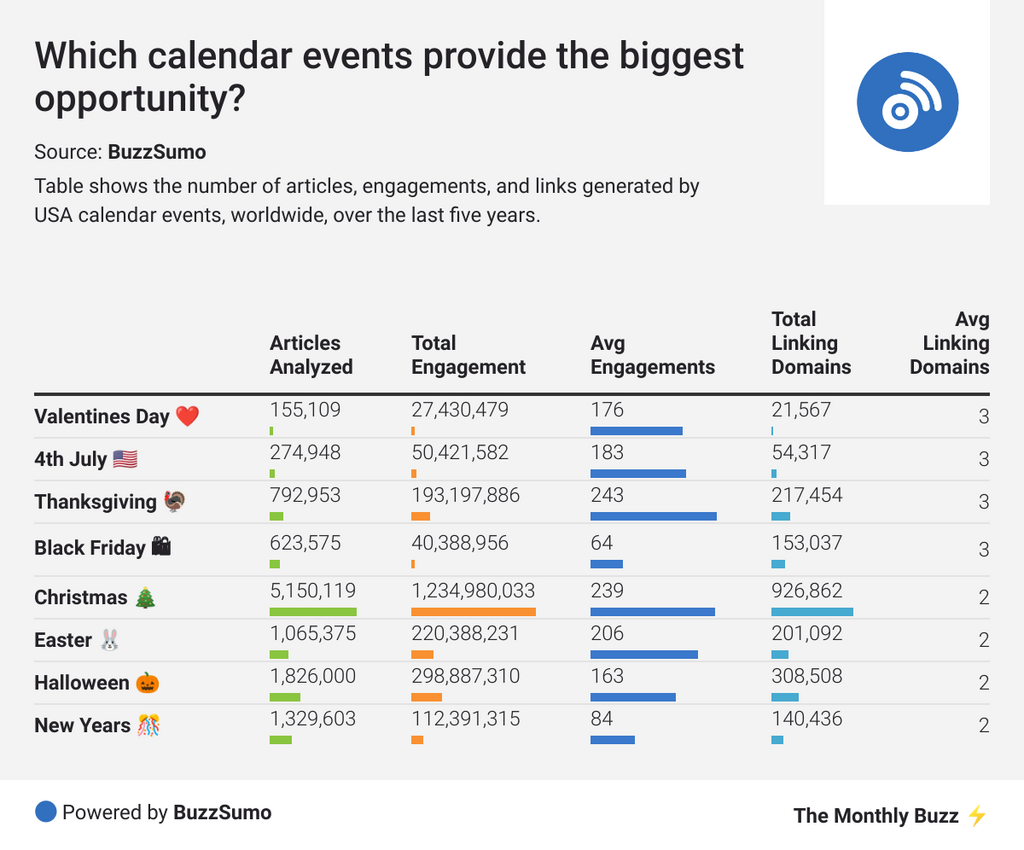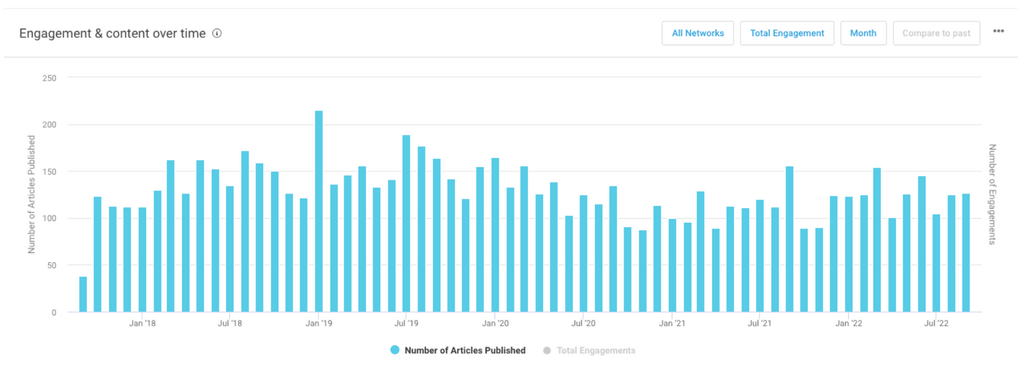Journalists are the OG influencers.
For centuries they’ve had the power to push our brand and its content further than we ever imagined possible.
And yet, we still don’t really get them.
A quick search for the word “pitch” in the subreddit /r/journalism returns 237 results – many of which are from PRs, asking things like:
Or: “What makes a great pitch?”
We don't know what journalists want, and it's a problem.
According to Cision's 2022 Global State of the Media Report, 2 in 3 journalists say the pitches they receive are irrelevant.
That's why we've set out to tackle the PR pitch once and for all.
In the first half of this report we’re going to unpick the power of the journalist, and in the second half, we’ll get to grips with what it takes to become pitch perfect.
TL;DR Findings
- Journalist content lands 315 engagements on average, while non-journalist content achieves 114.
- Journalist content is 2.76x more engaging.
- Journalist content encourages 9x more Facebook Reactions on average.
- The marketing industry is the most likely to benefit from journalist mentions, while travel is the least.
- 38% of brand alerts in our study contained at least one journalist mention over the past quarter.
- 5% of total brand mentions (12.5m) in our study came from a journalist.
- Of the journalists that mentioned brands, 23% of those included a link – meaning 77% of journalists don't link.
- Journalists are just as likely (or just as *unlikely*) as non-journalists to link out to external sources.
- Journalists most commonly refer to themselves as "Writers", "Journalists", and "Editors".
- Health journalists are most likely to engage audiences with "Why" content, while Entertainment journalists are more likely to attract with "Lists".
- According to SparkToro the top journalist request hashtags are #journorequest #prrequest #bloggerswanted #bloggerrequired #bloggerrequest
- Fashion journalists are most likely to evoke love reactions, while tech journalists are most likely to wow readers.
- 65% of journalists saying that their number one pet peeve is being spammed repeatedly by email or phone.
- 48% of journalists said that the number one thing a PR can do to get in their good books is to “Understand my current beat and position, and make their pitch relevant to this.”
- 62% of journalists say that up to a quarter of the stories they end up publishing come from their own outbound requests for content.
Contents
The opportunity
- How much more engaging is journalist content than non-journalist content?
- How does the "Journalist effect" play out across different industries?
- How much more emotive is journalist content?
The challenge
- How likely is it for a journalist to mention a brand?
- What percentage of brand mentions come from a journalist?
- How likely is it for a journalist to link?
- How likely is it for a journalist to link to your brand?
The solution
- How to find the right journalist, and prioritize their needs
- How do journalists refer to themselves online?
- What kinds of content do journalists create and share?
- Top journalist hashtags and phrases
- What type of emotions do journalists evoke?
Part 2
Methodology
We analyzed our database of 600K+ journalists over the last year to get to grips with who they are, how they create, and what they want.
In BuzzSumo, we define a journalist as someone who writes for a popular online media publication, and track a huge whitelist of media publications.
We also pay close attention to journalist-related positions referenced in a users’ Twitter bio, and use this data to connect journalists to their published content.
And lastly, of course, we analyze billions of social engagements.
“Engagement” is a catch-all term to describe all the ways an audience can interact with a piece of content shared on social media; including comments, likes, pins, upvotes, and reactions.
BuzzSumo specializes in monitoring this engagement and, since 2021, has given you the ability to assess the engagement of journalist content, with Journalist Profiles.
Data collected by Henley Wing Chiu, report written by Louise Linehan.
The opportunity
If you were in any doubt of the value a journalist can add, we’ve conducted some wide-scale research to underscore the power of the journalist, and their ability to drive home blockbuster engagement.
How much more engaging is journalist content than non-journalist content?
We analyzed 673M pieces of content to work out just how much more engagement journalist content is able to drive.
On average, journalist content manages to rack up 315 engagements, while non-journalists achieve a comparatively modest 114 engagements.
Journalists also have the ability to generate more than double the amount of awareness when compared with non-journalists.
Andrew Bruce Smith
“Content written by journalists for a recognised media outlet is far more likely to generate social media amplification and engagement. Period. Anyone using BuzzSumo’s Content Analyzer will have known this for years. But this new analysis of a huge sample of content provides even more robust evidence. It reinforces the fact that an optimal content strategy will involve a combination of media relations and creating your own content – for both social and SEO purposes. BuzzSumo provides the data to allow you to make informed decisions about how best to allocate your resources to gain maximum impact.”
While there’s no question that journalists create top-tier content, it would be wrong of us to suggest that they don’t benefit from the in-built audiences and content syndication networks of the large publications they write for.
Nevertheless, quantifying this engagement can help you estimate the increased reach that your brand or client stands to benefit from, if they land that all-important journalist mention.
By power of association, not only can they increase awareness, but build authority and credibility in the eyes of the reader.
Tamara Sykes
“This is an important aspect of business growth! Third-party validation from recognized and relevant media outlets increases trust among your customers and employees.”
How does the “Journalist effect” play out across different industries?
According to the data, journalists are most likely to generate engagement with entertainment content. Each individual article averaged an impressive 1,071 engagements – that’s over 3x the amount that a non-journalist is able to attract with the same kind of content.
But when it comes to travel content, the engagement gap closes, and non-journalists have a far better chance of attracting attention. In this industry, journalists are only 1.5x more likely to generate interest when compared with a non-journo.
This data will come in handy when you’re building a business case for investment in journalist relationship building.
Tamara Sykes
“Using PR (digital and traditional) tactics should always be viewed in the context of a business’ industry and their marketing goals. If you learn that it won’t move the needle significantly, it would be best to invest time and effort in a different growth method.”
To help you with just that, we’ve re-visualized the same insight to show you the industries that benefit most from journalist coverage.
Journalist-created marketing content receives 188% more engagement than marketing content created by non-journos.
If you work in this industry, building strong, authentic connections with journalists is essential for improving awareness.
How much more emotive is journalist content?
We analyzed 4.2 billion Facebook reactions over the last year, and found that journalist content is 9x more likely to generate a reaction compared with non-journalist content.
On average, journalists give rise to 75 reactions per piece of content, while non-journalists produce just 8.
This could be symptomatic of the increased reach that publications wield, but the data still makes a compelling case for investing energy into journalist relations.
This stat speaks to the objective view that journalists typically bring to the content they create. In the PR industry we stress that they focus on the story that will connect with their audience rather than producing advertorial content, which can be a tendency of non-journalists.
Tamara Sykes, Outreach Manager, Stacker
The challenge
Forming a connection and building trust with a journalist is just about the most important thing you can do as a PR.
But how often do PRs get it right? And how much awareness do they tend to generate?
How likely is it for a journalist to mention a brand?
We studied 3,016 brand alerts found in BuzzSumo’s Monitoring and Alerts tool over the last three months.
Brand alerts are notifications that marketers set up to discover when they’ve been mentioned in content online.
In BuzzSumo terms, they refer to the overarching query set up by a user surrounding their brand.
Usually, alerts are only made up of the brand name, but may also include filters such as additional keywords and country-specific domains.
Using BuzzSumo’s Journalist Profiles feature, we discovered that 1,143 brand alerts had landed a mention from a journalist.
This meant that 38% of brands had been name-dropped at least once by a journalist over the past quarter.
Not a figure to be sniffed at, when you consider that outreach and PR pitching is one of the trickiest tasks a PR has to undertake.
In fact, according to a Twitter poll of 94 PRs carried out by Thea Chippendale, Head of Digital PR at Media Vision, 37% of you think outreach is the hardest part of Digital PR, second only to PR campaign ideation.
Yes, PR outreach is difficult! It’s more than sending an email. It requires research to find the best journalists to contact, collecting and organizing assets from the brand you represent, and facilitating interviews between spokespersons and journalists. Then PR campaign ideation can be tough to navigate since the PR must get buy-in from the client, which is doable but still a challenge. Sometimes brands want the story’s focus to be about them and their achievements but that’s not usually what will earn them coverage.
Tamara Sykes, Outreach Manager, Stacker
What percentage of brand mentions come from a journalist?
It’s important to note that behind each brand alert are thousands of individual mentions.
During our study, we analyzed 12,530,039 mentions over the course of three months.
So, how many of these mentions came from a journalist?
On average, we found that 5% of all brand mentions in our study came from journalist content.
So if 5% of mentions come from journalists, that means the remaining 95% come from non-journalists.
At risk of stating the obvious, that’s a fairly big difference! And it just underscores the challenge that PRs face every day, when it comes to pitching their brand as relevant and valuable in the eyes of journalists.
To say you should treat this 5% as a KPI for your own brand mentions would be to oversimplify things.
While it’s always important to take a temperature check and set goals, the process of building strong working relationships with journalists shouldn’t be one that is metric-obsessed.
Say it louder! Relationship-building is a long-term play. Applying metrics to this crucial art of PR turns it into a transactional relationship that doesn’t typically yield consistent results.
Tamara Sykes, Outreach Manager, Stacker
The more you numericize relationship building, the more you risk depersonalizing the process, and alienating a journalist altogether.
"For a decade now, I’ve cautioned marketers about the “robot invasion in Digital PR”, where agencies prioritize emailing hundreds of writers in one fell swoop, instead of building a relationship with the person on the other side of the inbox."
Kelsey Libert, Co-Founder, Fractl, in 4 Agency PR Tactics That I Avoid At All Costs
Being hyper-focused on targets will lead to desperate practices like pitch-spamming.
And if you prioritize the quick-win, you’ll end up wasting time in the long run.
As Gisele Navarro, Founder of NeoMam Studios, writes:
“When you plan and execute outreach campaigns that automate a vast majority of steps in the process, you’re leaving the human in you out of the equation. That is the moment when outreach is no longer a human to human connection, at that point your outreach is just spam.”
According to Cision’s State of the Media report, 43% of journalists want PRs to stop spamming them, and 74% of journalists simply won’t tolerate it.
Our own survey data backs this up, with 65% of journalists saying that their number one pet peeve is being spammed repeatedly by email or phone.
And, just to drive that point home a little further, journalists across the /r/Journalism subreddit are very vocal about their hatred for spam, with many stating that they immediately delete it.
“If you keep spamming the inboxes I’m just going to delete everything because I don’t have time for that. The few PR people I do have good relationships with have all been through direct contact, not-mass-spam emails. My suggestion is: pick one or two reporters that you can build a relationship with. Talk to them as human beings first, and then after building that relationship, pitch them the stories they’ll be more likely to respond to.”
Jaded-Cheesecake-423, Reporter, Reddit discussion: PR person here concerned about our bad rap
Being KPI-consumed or scale-obsessed is a recipe for disaster when it comes to pitching journalists.
Instead be selective, patient, and above all else, human.
How likely is it for a journalist to link?
When it comes to including any link in their articles, journalists are just as likely (or just as *unlikely*) as non-journalists to link out to external sources.
We took 10K articles written by journalists and 10K articles written by non-journalists published between July 2021 - July 2022, and found that the average number of links to external domains for both groups came in at an incredibly modest 2.1.
Journalist links can sometimes be elusive, so giving them a reason to link is all-the-more important.
You can do this by pitching unique hero content, exclusive angles, primary data, and expert commentary.
Yes! The link has to bring value to their piece or provide a story angle that hasn’t been addressed before. The idea that journalists must include a link to your content because it may seem relevant is a misconception.
Tamara Sykes, Outreach Manager, Stacker
How likely is it for a journalist to link to your brand?
We also studied the percentage of brand mentions that had been linked to by a journalist.
Our research shows that 23% of brand mentions are linked to from journalists – meaning 77% don't link.
The solution
How to find the right journalist, and prioritize their needs
What is the solution to better pitching journalists?
It’s all about finding the right journalist, and getting to grips with who they are, how they create, and what they want.
How do journalists refer to themselves online?
One way to find journalists is to identify them based on their title or position. While email is unsurprisingly the favored channel for PR pitching, our study showed that 14% of journalists preferred to be pitched to via social media.
So we took our analysis over to Twitter, and studied the Twitter bios of 600K journalists, to understand how they refer to themselves online.
Only a small percentage of journalist profiles shared relevant title-specific words in their bios.
Nevertheless, it was interesting to find that more journalists refer to themselves as “Writers” over “Journalists”.
Try using a combination of these keywords in your process of journalist discovery.
Here are two ways to do just that:
Search journalist-related keywords in Twitter bios
Start your discovery process by searching “Writer” or “Journalist” on Twitter, and heading to the People tab.
This will automatically suggest 2nd or 3rd connections featuring those words in their bio.
Search journalist-related keywords in BuzzSumo's Media Database
Head to the Journalist Database in BuzzSumo and search a job title in the “Biography” search...
These kind of techniques are great for building a media list of journalists, but effective pitching is not about scaling your efforts.
It’s crucial you find journalists that have a vested interest in what you’re pitching.
Hone in on journalists with a beat that’s relevant to your niche, by appending a relevant topic...
Following on from this, you can find out even more about a journalist in their Journalist Profile.
But more on that later!
Another way to get to know a journalist is by taking a look at the content they’re already putting out there…
What kinds of content do journalists create and share?
The most engaging journalist content types
When you’re contacting journalists, do you know what kind of content you should be pitching? Which style of article they prefer to write? What topics will they most readily cover?
This kind of intel is not only helpful for crafting a relevant PR pitch – it can also give you great content ideas from the outset – since you’re working to a formula that you know already engages.
We’ve taken a look at the most engaging content types written by journalists across different industries, to give you inspiration for your next PR pitch.
When you’re preparing your pitch, make sure you take content types into consideration.
If you’re pitching entertainment content, for instance, make sure you feature bitesize points in your pitch that journos can easily turn into lists, since this is the most likely format to engage their readers.
According to Cision, journalists are feeling the pressure right now to drive audience engagement, as advertising revenues decline.
59% of journalists say that they pay close attention to audience engagement data when evaluating stories.
That's pretty significant.
Doing the heavy lifting for them, and qualifying the potential engagement of the story you’re pitching, can make for a far more compelling PR pitch.
We analyzed 200K pieces of journalist content to help you do just that!
Here’s a full list of the most engaging journalist content types across different industries, complete with examples:
Marketing 👩🏽💻 How to content – ie.
Health 💊 Why posts – ie.
Entertainment 💃🏿 List posts – ie.
Tech 📲 What posts – ie.
Travel 🏖 Interviews – ie.
Fashion 👗 Why posts – ie.
Business 👔 Why posts – ie.
Sport 🥎 List posts – ie.
And remember, the more personal you get with your pitching, the better.
If you have a specific topic you’re pitching, analyze how journalists prefer to create content around it.
For example, imagine you’re a Marketer at Spark PR looking for pitch-worthy campaign ideas for your client eHarmony. If you search “dating” in the Content Analyzer…
… toggle on the Journalist filter
… and fire up the Analysis Report…
… you’d quickly learn that the most engaging journalist content around this topic usually summarizes “relationship and dating” based podcasts.
With this information, you might re-ignite eHarmony’s podcast and pitch an exclusive discussion topic.
Or use BuzzSumo’s Journalist Profiles to identify journalists that have previously mentioned any competitors.
Take the journalist below. They have written a feature all about rival dating app, Hinge, so may be open to covering a story around eHarmony.
Whatever method you explore, honing in on beat-specific and relevant journalists is imperative when pitching.
Think:
- What formats of content do they prefer to create?
- How recently did they cover this topic?
- What beats do they commonly cover?
- What publications do they regularly write for?
- How do they write? What language do they use?
- What interests them?
- And most importantly: How can YOU help THEM create engaging content?
Top journalist hashtags and phrases
Using SparkToro, an awesome audience research tool, we discovered which topics journalists are discussing and sharing most on social media.
To do this we analyzed the hashtag #journorequest, which is popularly used by journalists to source PRs and contributors for features.
This gave us access to 3,384 journalist accounts across the globe. Here are the other hashtags they were using:
One thing that jumped out straight away were all the other related hashtags journalists use when actively looking for contributors:
- #prrequest
- #bloggerswanted
- #bloggerrequired
- #bloggerrequest
Make sure you start following these hashtags. Fulfilling a journalist request is a great way to build a relationship, since you’re helping them out and pitching to them when they’re most receptive.
Being proactive will make you a memorable and trusted source that they’re more likely to come back to.
Stacey MacNaught gave a great presentation on this method back in 2021 at BrightonSEO, and now has journalists seeking out her clients for all kinds of features.
Another thing to note about these hashtags is that they commonly feature calendar events (ie. Mental Health Awareness Week, Valentine’s). Pitching these kinds of topics will be more likely to get you on a journo’s radar.
To become even more proactive, create and maintain a Publicity Calendar that’s relevant to the brands you represent. You can house such a calendar in Notion, Google Sheets or GCal.
Tamara Sykes, Outreach Manager, Stacker
Here are some other commonly occurring phrases shared by journalists on social that might pique their interest in your PR pitch:
What type of emotions do journalists evoke?
Creating a newsworthy story is all about evoking an emotional response from the audience.
You want to make them care enough to share.
As we already know, journalists have an impressive ability to do just that.
So when you’re pitching journalists, knowing what emotions they tend to evoke can help you shape a story that will resonate with them and their audience.
“I genuinely think if you can come through [the ideation] phase with an idea that’s linked to successful themes and that taps into 1-2 emotions, you are already on your way to running a winning campaign.”
We took a top-level look at the types of Facebook reactions that are most commonly invoked by journalist content across different industries.
When it comes to journo content, there’s a lotta love to go around 💖
Audiences across five of the eight industries primarily engage with content using the love reaction – most notably in Fashion, Marketing, and Entertainment.
Meanwhile, Health and Business journo content is least likely to land a love reaction. Instead, the former is the most likely of all industries to evoke sadness, while the latter has the greatest ability to anger.
If a journalist writes about Tech, they’re most likely to amuse or wow their audience when compared with journalists covering other industry beats.
So, what does all of this mean?
Well, what it doesn’t mean is that you should start creating provocative pitches for the sake of it.
Instead, use this information as another tool for understanding the journalist you’re pitching to: what they’re most likely to want to write about; what tone their content is most likely to take.
You can take this research further yourself by diving into a niche topic in BuzzSumo.
For example, if you wanted to analyze journalists covering “Artificial intelligence” as part of their Tech beat, just search it in the Content Analyzer…
You’ll see related topics or beats beneath the search bar. If you want to expand your search, hit the “OR” button.
Then toggle on the journalist filter…
And hit “View Analysis Report”
This will give you a top-level analysis of journalist content in that specific niche. Now head to the “Reactions” section.
And from this you’ll know that Tech journalists will want their audiences to be wowed by their content, which should give you an idea of how to pitch.
To see the articles behind the emotion, head back to the Content Analyzer and hit “More filters”
Then select a “Dominant reaction” filter.
This will let you zero in on the headlines and journalists creating the strongest emotional response.
You can also analyze audience emotions by hovering over the Facebook icon next to a headline.
Then simply hit the Journalist Profile to research a specific journalist, including their beat, past headlines, and top publications.
Gisele Navarro from NeoMam Studios advises PRs to “Tailor pitches to verticals by writing subject lines that mirror their headlines.”
Reflecting the language and emotion journalists most successfully evoke in your subject line can be the difference between your PR pitch being opened or being canned.
How to pitch to journalists
Journalists are time poor and pitch rich
According to Cision’s 2022 survey of 3,800 journalists, more than 50% of journalists receive over 50 pitches a week via email, phone, and social media. A further 24% receive up to 100.
Here’s how to create a scroll-stopping, junk-evading pitch…
Keep it relevant
We surveyed published journalists, and 48% said that the number one thing a PR can do to get in their good books is to “Understand my current beat and position, and make their pitch relevant to this.”
When asked about the best example of a cold pitch they’d ever received, one journalist stated “A cold pitch where the person showed they had followed my advice for 3 months and the results they achieved.”
This is an extreme example of personalization, but the fact remains that journalists need proof that you understand them and their audience.
Here’s some key things to consider about a journo when pitching:
Their beat
Know what a journalist is writing about right now – not two months ago. Check their social profiles for recent content, or:
- Head to BuzzSumo’s Media Database
- Search your topic
- Set your recent article count
- View the “Topics” in a Journalist Profile to confirm their beat
- Set their articles to "Most recent" to view their latest writing
Their position
Make sure they’re the right person to be contacting, and check if they’re likely to cover your story.
Writers on SEO desks don’t tend to accept pitches for example.
Pay close attention to the positions listed in their social media bios, or on the Contact Us page of a publication.
Dig deeper on social media or HARO to check whether a journalist has ever requested contributions or published PR pitches in the past.
Here's a handy list of journalist titles to pitch to, and what they mean.
Their recently published content
If you reference or praise recent content, make sure it is recent.
Their most engaging content
Tapping into the formula that led to a journalist’s most successful piece of content is a great way to customize your pitch.
It shows you’ve taken time to understand what works well for them and their audience.
This could be reflected in the subject line/headline you propose, or the data/expert you pitch.
Whatever the case may be, just make sure your proposal is relevant to the journalists current beat.
Their audience’s reactions
Look at the reactions the journo you’re pitching most often evokes.
Then pitch how your story can garner that same reaction.
The language they use
Pay attention to the language the journalist uses, and build it into your PR pitch.
Gisele Navarro
“Pitch your content to each vertical and region in your target list using words that fit their way of writing, and highlighting points that align with their way of breaking news.”
Their style of referencing
Does the journo you’re pitching usually provide a link? Do they like to use expert commentary?
Make sure you know this before you begin pitching, to save yourself time.
Here's 3 ways you can find that out:
1. Check back through their content archives using BuzzSumo's Media Database
2. Set up alerts for your competitors in BuzzSumo Monitoring & Alerts, and toggle on "Show mentions with links"
Then look out for journalist icons in your competitors' mentions.
Pro Tip
3. Find the journalists that accept expert commentary via Google News by searching “according to” + “keyword”
Tip from:
Stacey MacNaught,
SEO and Content Marketing Consultant, MacNaught Digital
Any former PR requests they’ve made
Look through successfully published articles as a result of prior journalist/PR collaborations, and use this information to inform the topics you pitch them, as well as your style of pitching.
Pro Tip
Search #journorequest + keyword on Twitter
Knowing what a journalist is writing about right now is half the battle.
Many PR requests are for expert commentary, but if you're reactive, you may be able to provide something relevant other than – or as well as commentary – ie. data or a press release.
In this scenario you need to be absolutely certain that your pitch is relevant, and that there's a strong reader hook, since you're taking more of a risk by giving the journalist something other than what they've requested.
In other words, you risk being excommunicated if you waste a journalist's time. No pressure!
Kelsey Libert
"I've seen an increasing number of publishers asking for interviews or expert commentary to go along with campaigns. Be proactive in providing this by leveraging client quotes as part of your pitch. If your client isn't an expert on your campaign's given topic, then look to HARO, Qwoted, Twitter, or other sources that will help you curate this expertise to help land your placement."
Pitch proactively
Another great way to pitch is to be the source of a journalist’s ideas.
Journalists are always on the hunt for contributions. In fact, 62% of the journalists in our survey say that up to a quarter of the stories they end up publishing come from their own outbound requests for content.
Make sure you’re there when they need you, and preempt their writing with stories, commentary, and data ahead of time.
If you’re constantly pitching stories that have already been written, your efforts will be futile…
Here’s how to pitch proactively…
Track journo requests
Listen closely to journalists when they ask for help. Whether that’s by heading to Help A Reporter Out (HARO), or keeping a keen eye on the hashtag chat #journorequest.
Here’s a nifty way you can automatically bank those requests using IFTTT, thanks to Andrew Dipper, Head of Marketing at streamGO:
You can also extend this IFTTT automation, and build requests into your day-to-day via Slack or your workflow management program of choice.
Find journos who are already fans
Discover and introduce yourself to the journalists already mentioning your brand/clients.
Just set up a brand alert in BuzzSumo and keep an eye out for Journalist Profiles in your mentions.
Here’s an example for Expensify:
Don't pitch anything at first
Offer your brand/client as a resource that a journalist can call upon when the time comes for them to write.
Hana Bednarova, founder at ShoutBravo, has seen great success with this technique, with a 60% open rate on her proactive outreach, frequent replies within the hour, and exclusive invites to journalist communities via Facebook groups, WhatsApp groups, and Slack channels.
Pitch around seasonal and recurring themes
Prepare pitches for timeless content themes that always make the news.
Seasonal celebrations
- Christmas
- Thanksgiving
- Diwali
- Halloween etc.
We did some research for our newsletter, The Monthly Buzz, into the seasonal content that drives the most engagement on social media.
Check it out below, and recreate it yourself in the Content Analysis Report tab. Just make sure you toggle the "Journalist filter" on, to find out which calendar topics a journalist will bite your hand off to write about.
Ecommerce occasions
- Black Friday
- Cyber Monday
- Prime Day etc.
Earmarked months
- Veganuary
- Mental Health Awareness Month
- Movember
- Stoptober etc.
National holidays
- Juneteenth National Independence Day
- Labor Day
Bizarre "Days" of the year
- Star Wars Day
- April Fools Day etc.
Yearly or recurring events
- MET Gala
- SuperBowl etc.
Timeless news themes
- Celebrity news (ie. relationship status)
- Extreme weather
- Protests or strikes etc.
PR campaign formats that always land links
- Dream jobs (ie. "You can now get paid to" content)
- Reports and studies
- Infographics
- Data campaigns etc.
Check out this cool report Bottled Imagination created using BuzzSumo data, to discover the PR campaign formats that are on the up right now.
Give the gold up front
Don’t bury the gold. Be to the point in your pitch, and make sure the most important content is up front and in a journalist’s face…
And remember: Who cares and why?
Think of the value a journalist's audience will get out of the story, before you think of the value your brand/client will get out of it.
Tie your pitch to a news hook
Newsjacking is a great way to catch the attention of a journalist, if it’s relevant to their beat.
And this is because news or trendjacking prioritizes the story. Journalists hate receiving tons of buzzword-packed, jargon-laden, ad-heavy pitches.
Give them a good story, and you’re far more likely to move from pitch to publish.
But according to a poll by Jered Martin, Co-Founder of One Pitch SAAS, 29% of PRs agree that newsjacking is the most difficult type of PR to secure.
So, how do you do it effectively? Read our newsjacking do’s and don’ts from a BBC journalist, or get trendjacking advice from our agency customers Reboot Online.
You can also check out how Connective3 uses BuzzSumo’s Trending Tool to ride the wave of viral topics.
Be in it for the long haul
In our survey of what journalists most want to see from PRs, 22% of participants said PRs can get in their good books by trying to build a genuine relationship with them first.
Go in with the goal of making a friend, and think favor-first: What can you do for them.
Take if offline
Build more meaningful connections with journalists offline at events and in-person meetups.
Here’s a response we received from a journalist we surveyed, proving the importance of meeting IRL.
“I don’t typically do anything with press releases due to my job being investigative. I have however had a marketing guy from a tech company connect on LinkedIn. We met for coffee just to talk in and he wanted to offer his knowledge on tech if I needed it. I actually went and found a story that I could use him for as a source – that’s a good PR person, who makes me come to them simply by being nice and offering their help and time.”
Surround yourself with a journalist's work
Build a genuine opinion on your journalist’s content and keep on top of what they’re creating.
Pro Tip
Set up a journalist alert
Once you've found your dream journalists in the Media Database, set up an alert to get notified every time they publish new content. This will help you get to know them, their topics, and style of writing over the course of weeks or months.
Time it right
Closing dates don't count – get faster!
According to Surena Chande, former SEO Editor at the Mirror and Daily Star, journalists will choose their collaborators from call-outs or #journorequests, in as little as five minutes!
Whether you're tuning into Twitter journalist requests via IFTTT alerts, scouring HARO, or responding to a journo request in your inbox, time is very much of the essence.
In instances like this, you need to be prepared to be reactive.
Here's some ways you can do that...
Pro Tip
Get faster with a "Good to go" Google Drive folder
Tips from Stacey MacNaught:
- Interview clients straight away, via a Google Form, to keep information on record for journalist requests (email, bio, contact details etc.)
- Pre-prepare signed-off comments from clients on relevant topics
- Include expert/contributor images and headshots (color, black & white, transparent background etc.)
- Interview anyone and everyone in the business, about both their role and themselves (ie. strengths, weaknesses, education, first job, worst job, values etc.) as their comments can be used for all kinds of journalist requests
- Include ready-collected, exclusive data and statistics on relevant topics
- Get everything pre-signed by all involved
Pitch early in the day
Time your pitching right so that journalists are more receptive. Here's a handy tip from a reporter via Reddit.
“Timing is everything. Every newsroom is different, but for some journalists it would be best to have a PR email sitting in their inbox at, say 8:30 am if they have a pitch meeting later in the morning. For embargoed stuff, I like a few days' notice just so I can prepare to pitch/cover it if it's a story I'm actually interested in. Emails sent at clock-off time are destined to be ignored, and there's nothing more irritating than when someone cold calls me when I'm close to filing a story.”
Kanzac, Reporter, Reddit discussion: PR person here concerned about our bad rap
Align with editorial calendars and pitch during cyclical lows
According to Cision’s personalized PR whitepaper, a third of journalists file 10+ features a week.
Read: They are incredibly busy people.
But how do you pitch the kinds of things they're looking for, when journos really don’t want to tell you their publishing schedule…
If you know their beat, take a look at trend data to gauge peaks and troughs in demand and readership.
You can use trusty Google Trends for this, or tap into the social zeitgeist using BuzzSumo’s Content Analysis Report tab.
This is a five year record of articles published by journalists on the subject of “Nutrition”.
Some slicing and dicing of the exported data told us that "Nutritionist" journalists are 9.2% less likely to publish content on this topic during the months of November and December, and 9.3% more likely to publish in the months of March and September.
Anticipating down-time in a journalist's editorial calendar is just about as shrewd a move as you can make when pitching.
“One thing folks haven't mentioned already: every beat has cyclical highs and lows—if you're trying to pitch something close to, say, Election Day for anyone with a municipal/city beat, your stuff's ending up in the trash. If you time it right with one of the cyclical lows, however, your chances go way up (gotta feed the beast, after all). Likewise, if you have something to pitch that can be tied to a specific time of year/event/etc., time it so your email's arriving a month or so in advance. Having a feature in the can that can slot in easily (especially if it's holiday-related, when newsrooms are going to be short-staffed) can be invaluable.”
A-german-muffin, Reddit discussion: Dear Journalists, I'm a PR person who wants to stop sending you sh*tty pitches. Can you share some examples of good ones?
Can the canned statements
Journalists love exclusivity. If you’re giving the same canned statements to all the people you pitch to, then where is the value in that?
If you’ve got one press release, story, piece of data, or expert to pitch, try upcycling that content into as many different angles as possible.
You don't want to be the reason journalists are creating carbon copies of each other's work, and upsetting their Editors in the process.
Don't cross the creepy line
It’s one thing trying to build a legitimate relationship with a journalist, and quite another when you’re using creepy means to form that connection.
Keep it professional, and contact them via the correct channels.
According to the journalists in our study, 86% prefer to be contacted via email, 9% via social media DMs, and 5% via hashtag chats.
Be recognizable
Raise your profile (or your clients') on the channels that your chosen journalist has a predilection for.
Use SparkToro to understand the podcasts and publications a journalist consumes, and – if you can’t feature in this content yourself – take learnings from the style and stories to inform the content you share, while connected with your target journalist.
Recognition could be the key to your pitch being published, especially if the journalist respects your knowledge and opinions.
Here's 3 ways to do that:
1. Aim for engagement
The more engaging your posts, the more likely you are to get on a journo's radar, the more willing they’ll be to work with you. Plus, strong engagement will serve as a proof point for the interest you’ll be able to generate for them. Equally, remember, it's not all about you! Show them some love. React to their content. Form an opinion. Drop it in a comment.
2. Share what you’ll pitch
Try to be recognizable for the types of content you intend to pitch. For example, if you’re looking to raise the profile of an expert client, share their views on a relevant topic. Or, if you’re pitching primary data, share other example of primary data campaigns you've run, as well as first-hand statistics. But don't give away too much! Save the gold for the pitch.
3. Drop some names
Interact with those they're connected with, so you're more likely to pop up on their feed. If you’ve already been published by other journalists they’re connected with or publications they’ve written for, name-drop those connections in your pitch to underscore your trustworthiness and credibility.
When a journalist recalls you, they’re far more likely to open your email and pick up your pitch.
Don’t be demanding
According to our research, 17% of journalists can’t stand it when PRs follow up with them repeatedly on the progress of a piece of content.
Some journalists also report PRs attempting to control the edit of a story, and making demands on wording.
As you can see, this style of interaction plain gives writers the ick.
Just don’t do it.
And the general consensus is that you should only follow up once when your pitch has been accepted, unless a journalist requires more information from you.
“Continuous nagging about when the story will be finished really rubs me the wrong way, and might ensure that I'll drop the story if I'm unsure about how interesting it'll be.”
CuckJockey, Reddit discussion: PR person here concerned about our bad rap
Tap into Twitter
Social media is packed full of gold when it comes to pitching advice, and more often that not it comes straight from journalists themselves, so try following hashtags like #PRtips, or set up social media listening on some key phrases to help you perfect your pitch.
Here’s a bunch of great Twitter threads on how to pitch:
- This one from Tom Chivers shows you how to use BuzzSumo data to build a journalist seeding list and find journalists that most commonly cover any topic you can think of
- This one from Ellie Morgan at Evolved Search, which curates journalist tweets with some top takeaways
- Digital PR tips takes a similar approach with this 2022 roundup
- This list of top 10 tips comes from Georgia Anderson, a former journalist
- And TV commentator, Angelica Malin, also shares 10 great pitching tips here
Let’s recap
Don’t underestimate the power of a journalist.
Getting a mention in their content will earn your brand between 1.5x - 3x more engagement and 9x more reactions on average.
That means new audiences and potentially even new business from a single shout out.
When it comes to organic promotion, they pack a punch. That’s why pitching is not a practice to be undertaken lightly.
Think them-first ALWAYS.
How to pitch:
DO ✅
🔬 Research and reference their:
- Beat
- Position
- Recently published content
- Most engaging content
- Language used
- Audience reaction/emotion
- Style of referencing
- Former pitch requests
📈 Track journalist requests for content via social media
🗳️ Find warm leads in journalists who’ve already vouched for you
🙋♀️ Offer yourself as a resource, before you have anything to pitch
📡 Get on their radar by being active online
🌟 Give your most important content up front
🪝 Tie your pitch to a news hook
🫥 Clearly outline the story or “hook” in your pitch, to help them do their job
🚨 Surround yourself with your journalist’s content, via alerts, social media, and newsletters
⌛ Time your pitch right – early in the day, and during a beat’s cyclical lows
🤫 Give exclusive stories, commentary, and data
DON’T ❌
⚰️ Bury the gold
🔣 Write a jargon-heavy brand ad as a pitch
🥫 Blast out the same one-size-fits all pitch, or canned statements
🔊 Pitch an exclusive if it’s not an exclusive
🕵️ Cross the creepy line and try to connect via personal channels
📥 Bombard journalists with feedback and follow-ups
🏃🏽 Make journalists chase you
You need to do everything you can to reinforce the value your content will add for a journalist.
Yes, you have a goal to achieve, but to do that you must make it all about them.
Now that you know how to pitch journalists, now you need to know where to find the networks that will help you get the most mileage out of your coverage.
We analyzed 6M links across 876M articles, to spot the strongest connections between publishers, and help you save time and money on press syndication.
Read our report: We Analyzed Millions Of Publisher Links. Here’s How To Syndicate Your Content & PR For Free.
We’d love to hear your thoughts and recommendations on what you think make for some of the best pitching practices. Let us know on Twitter, Facebook or LinkedIn.
And if you heard anything you liked about BuzzSumo, be sure to grab your 30 day free trial to try it out for yourself. We've also partnered with Cision to bring you an industry leading media database, which you can explore here.
Categories
Digital PRCategories
Digital PRThe Monthly Buzz⚡
Subscribe to BuzzSumo's monthly newsletter to:
Stay up-to-date with the best of the best in content marketing 📝
Get data-informed content, tips and tidbits insights first 👩🏻💻
Read top shared content by top marketing geeks 🤓
Try
Enter any topic, term or url to search to see BuzzSumo in action. It’s free!
100% free. No credit card required.
